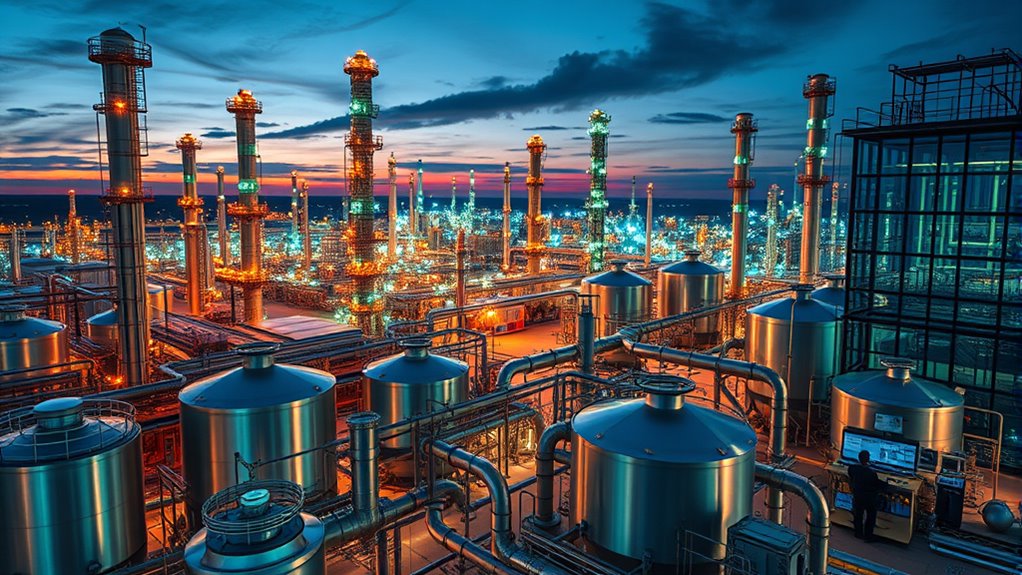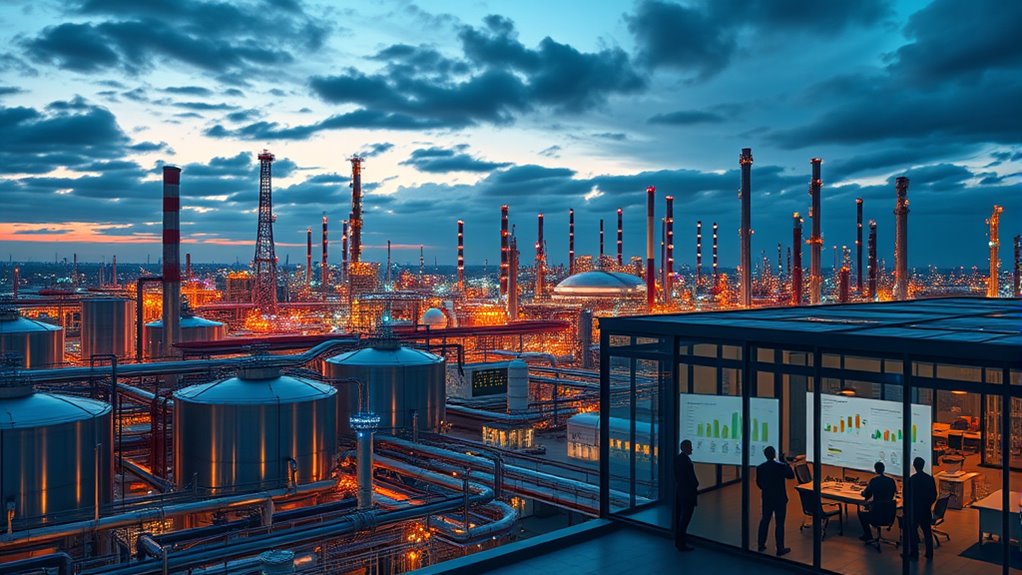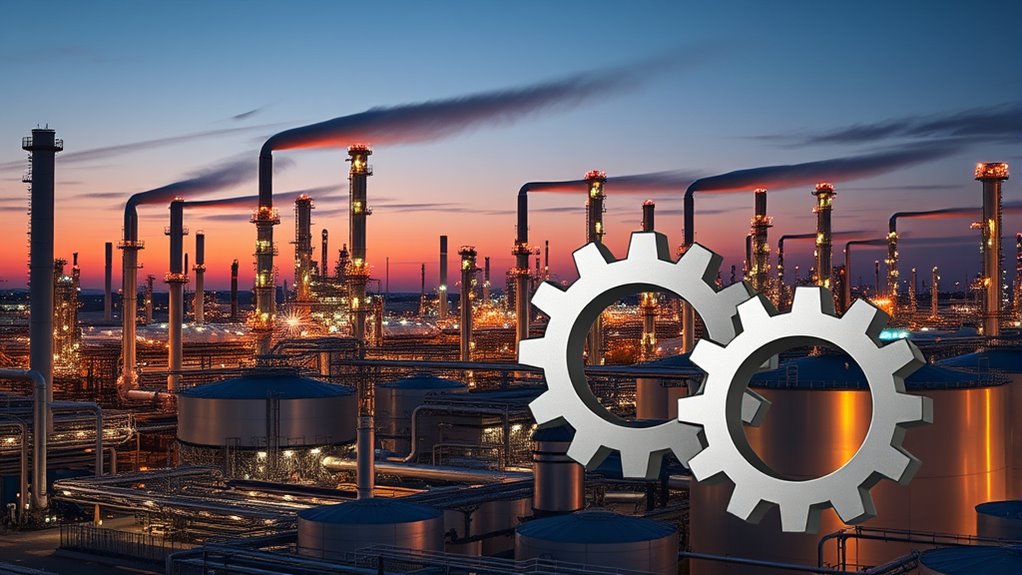In 2023, the chemical industry saw a slowdown in M&A activity, with deal values dropping and fewer large transactions, though specialty chemicals remained resilient. Industry leaders focus on sustainability, innovation, and geographic expansion to stay competitive. Consolidation helps companies cut costs, access new markets, and advance green technologies, but challenges like integration complexity persist. As regional dynamics and technological advancements shape the landscape, exploring these trends further can reveal how the sector is evolving.
Key Takeaways
- M&A deal volume in 2023 declined slightly, with a 30% drop in total deal value, indicating a cautious consolidation environment.
- Specialty chemicals showed resilience, while commodity chemical mergers focused on strategic acquisitions and geographic expansion.
- Sustainability goals and technological innovation are driving industry consolidation to enhance green capabilities and digital transformation.
- Regional and cross-border mergers are increasing, especially between Europe and Asia, to access new markets and raw materials.
- Smaller, strategic deals are predominant, with private equity seeking larger transactions amid economic uncertainties.
Recent M&A Activity and Industry Trends

Have recent M&A activity truly slowed down, or are companies being more strategic in their deals? In 2023, the global chemical industry saw 971 M&A deals, a slight decline from 977 in 2022. The overall volume reached its lowest since 2013, excluding pandemic years, with deal values dropping about 30% compared to the previous eight-year average. The number of deals has fluctuated over the past decade, with a notable decrease in 2023, reflecting shifting industry priorities. Despite fewer transactions, the specialty chemicals sector proved resilient, with only a 9% decline, while commodity chemicals experienced some large, strategic acquisitions like INEOS buying major assets from Eastman and LyondellBasell. Companies are focusing on sustainability goals, geographic optimization, and high-growth applications, shaping a more targeted M&A landscape. Even with reduced activity, executives remain optimistic about future opportunities, emphasizing deals that strengthen sustainability, resilience, and market positioning. Additionally, the evolving industry landscape underscores the importance of strategic alignment and innovation in M&A decision-making.
Factors Shaping Consolidation in 2023 and Beyond

Despite a slowdown in overall M&A activity in 2023, multiple factors continue to influence consolidation strategies within the chemical industry. Market volatility and economic uncertainty lead you to favor smaller, strategic deals over large acquisitions. Meanwhile, the anticipated recovery of liquidity in 2024 could rekindle bigger transactions. Margin pressures push you to pursue consolidation as a way to cut costs and boost efficiency. Technological advancements, like digital transformation and innovative product development, remain essential for staying competitive, prompting acquisitions for access to cutting-edge tech. Geopolitical tensions and regulatory shifts, especially around ESG standards, influence your geographic and strategic choices. Private equity involvement and fluctuating energy prices also shape your M&A decisions, with sector-specific dynamics further guiding your consolidation efforts. Industry progress in 2024 continues to support a cautious yet opportunistic approach to mergers, as companies seek to align with evolving market drivers and sustainability goals. Furthermore, the integration of advanced digital technologies can facilitate smoother mergers and operational efficiencies.
The Role of Sustainability in M&A Strategies

Sustainability has become a central pillar in shaping M&A strategies within the chemical industry, as companies recognize that long-term profitability depends on aligning business goals with environmental and social responsibilities. You’ll see many leading firms incorporating targets like carbon neutrality by 2050 into their M&A rationale, using green deals to drive growth and operational improvements. Additionally, integrating sustainable practices into corporate strategies can enhance a company’s reputation and stakeholder trust. ESG considerations now influence deal valuation and integration, with transparency and sustainability reporting becoming essential. M&A targets often focus on advanced recycling, circular economy models, and energy transition technologies to meet industry sustainability standards. Companies adopting these strategies tend to deliver superior shareholder returns. By prioritizing sustainability, you can differentiate your brand, access new markets, and position your organization for long-term resilience amid regulatory and consumer pressures.
Innovation, Technology, and Competitive Advantage

Innovation, technology, and competitive advantage are deeply intertwined in the chemical industry, driving companies to adopt advanced digital tools and invest heavily in R&D to stay ahead. Digital transformation, like AI and data analytics, improves customer engagement and supply chain transparency, giving you a competitive edge. Despite revenue dips, R&D investments are rising, fueling innovation and operational efficiencies. Retaining top technical talent is essential; offering research opportunities and innovation awards helps keep your team engaged. M&A deals are often motivated by access to new patents, technologies, and processes, emphasizing innovation’s importance. Digital platforms streamline workflows and accelerate product development by enhancing collaboration across functions. Additionally, understanding signs of spoilage in raw materials and products can help maintain quality standards and ensure compliance with safety regulations.
Geographic Expansion and Market Diversification

Have you considered how geographic expansion and market diversification can strengthen your company’s position in the chemical industry? Expanding within your region helps you tap into familiar markets, while inter-regional activity, especially between Europe and Asia, creates new collaboration opportunities.
Moving into new territories allows you to access raw materials, labor, and customer bases previously out of reach, boosting growth and resilience. It also helps you navigate different regulatory environments and reduce dependency on a single market.
Diversification through geographic expansion enhances your portfolio by integrating new technologies and products, leading to operational efficiencies and cost savings. Additionally, understanding local regulations and zoning laws is crucial for compliance and successful expansion.
While challenges like cultural differences and regulatory hurdles exist, the strategic benefits—like increased market share, risk mitigation, and innovation—make geographic expansion a crucial component of your growth strategy.
Outlook for Chemical Sector M&A in 2024 and 2025

As we look ahead to 2024 and 2025, the chemical sector’s M&A activity is poised for a rebound after a sluggish start in 2024. Deal volume and value increased in the second half of 2024, and this momentum is expected to continue into the first half of 2025 as economic and political uncertainties ease.
Smaller and mid-market deals will dominate, driven by corporate and private equity portfolio realignments. Private equity firms, with ample dry powder, may pursue larger or mega-deals in 2025.
Although the pipeline was reduced early in 2024, optimism exists for a stronger M&A environment once financial stability returns. Improving market conditions, geopolitical shifts, and regional feedstock advantages will further support deal activity into 2025.
Opportunities and Challenges in Industry Consolidation

Industry consolidation presents a range of opportunities that can considerably strengthen chemical companies’ positions in the global market. You can diversify geographically, reducing reliance on regions vulnerable to regulatory shifts or cost pressures. Entering high-growth emerging markets, especially in Asia, becomes easier through acquisitions, boosting resilience.
Consolidation also helps balance supply and demand by reallocating capacity more efficiently. It enables you to leverage local knowledge and customer bases for deeper market penetration. Additionally, economies of scale lower costs via shared infrastructure, procurement, and streamlined operations, increasing bargaining power with suppliers.
Innovation accelerates as pooled R&D resources target environmental challenges and disruptive technologies. Larger firms can better invest in sustainable practices and digital transformation. Top-rated laundry detergents are often incorporated into supply chains for industrial use, highlighting the importance of quality and efficiency. However, integrating complex supply chains, aligning cultures, and managing procedural differences pose significant challenges requiring careful execution.
Frequently Asked Questions
How Are Private Equity Firms Influencing Chemical M&A Trends?
Private equity firms are notably shaping chemical M&A trends by actively acquiring and consolidating assets to boost scale and competitiveness. You’ll notice they focus on underperforming or fragmented businesses, applying strategies like operational improvements, cost reductions, and digital upgrades to create value.
Their recent surge in platform investments, especially in the middle market, drives increased deal volume and industry consolidation, making them key players in shaping the sector’s evolution.
What Regulatory Changes Could Impact Future Chemical Industry Consolidations?
You should know that in 2023, global chemical M&A deals dropped by 16% due to regulatory hurdles.
Future consolidations will be heavily impacted by new rules like TSCA/FIFRA compliance gaps and REACH/K-REACH alignment issues, complicating cross-border transfers.
Changes such as phasedown timelines for PFAS and green chemistry incentives will also influence portfolio valuations, making due diligence more complex and increasing post-merger liabilities.
How Does Digital Transformation Affect M&A Strategies in Chemicals?
Digital transformation deeply influences your M&A strategies in chemicals by boosting innovation and operational efficiency. It helps you leverage AI, data analytics, and predictive tools to make smarter decisions quickly.
You can streamline integration, reduce complexity, and adapt business models to market changes faster. Digital initiatives also improve transparency across supply chains, support sustainable practices, and enable you to enter new markets more effectively, making your M&A activities more agile and data-driven.
What Are the Risks of Over-Consolidation in the Chemical Sector?
Over-consolidation in the chemical sector can cause serious risks, including reduced competition, which can boost prices by up to 20%.
You might face increased regulatory scrutiny and diminished innovation, as fewer players compete.
Market dominance could lead to greater bargaining power, influencing policies to your disadvantage.
Additionally, environmental and social concerns grow, risking reputation damage and stakeholder mistrust, ultimately challenging your company’s long-term sustainability and growth prospects.
How Will Emerging Markets Shape Future Chemical Industry M&A Activity?
You should watch how emerging markets will shape future chemical M&A activity, as their rapid growth and expanding middle classes create new demand for specialty and green chemicals.
Companies will target these regions to secure supply chains, access feedstocks, and benefit from government incentives.
Expect more cross-border deals, joint ventures, and investments in sustainable technologies, driven by regional growth, innovation, and a focus on environmental and economic opportunities in these dynamic markets.
Conclusion
As you navigate the evolving landscape of chemical industry consolidation, remember that every shift offers new avenues for growth and innovation. Embracing change with a strategic mindset can turn challenges into opportunities, helping you stay ahead in a competitive world. By focusing on sustainability, technology, and markets, you can position yourself for a brighter, more resilient future—where each progression gently guides you toward long-term success and industry leadership.









